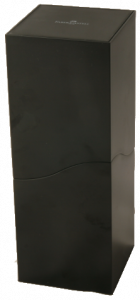Stephens wooden ruler 12″ / 30cm
 I bought this inexpensive wooden ruler from Ashton Print in Preston, Lancashire for 69p (1.08 US$, € 0.79). Since then I found that some online-shops sell it even cheaper. The ruler itself is 12″ / 30cm long and made in Australia by Stephens [1]The shop had a few Stephens rulers for sale. They were in a cardboard stand marked “Made in Australia. Carded in England.. This would be the perfect spot in this post to tell you a bit more about Stephens, but unfortunately I was not able to find any useful information about who they are or what products they offer, so let’s skip this part and go straight to the ruler.
I bought this inexpensive wooden ruler from Ashton Print in Preston, Lancashire for 69p (1.08 US$, € 0.79). Since then I found that some online-shops sell it even cheaper. The ruler itself is 12″ / 30cm long and made in Australia by Stephens [1]The shop had a few Stephens rulers for sale. They were in a cardboard stand marked “Made in Australia. Carded in England.. This would be the perfect spot in this post to tell you a bit more about Stephens, but unfortunately I was not able to find any useful information about who they are or what products they offer, so let’s skip this part and go straight to the ruler.

With about 12g the wood is quite light. So light in fact, that it feels fragile. It has less than half the weight of the wooden rulers I have used previously. Looking at the wood grain and taking the mass into account (12g for about 25 cm3 = 480 kg / m3) I would say the ruler is made from Aspen wood, but this is only a guess.

The ruler has centimetres and millimetres printed on one side and inches printed on the other side. The four corners of the inch side are further divided into eighths and sixteenths on the right and tenths and twelfths on the left. Additonally the middle of the inch side has 30°, 45°, 60°, 72° and 90° angles printed on them. This is obviously not a replacement for a set square, but a nice addition that could be of use. The printing on the ruler must have been created using some kind of stamping mechanism and is a bit irregular, which gives this ruler an “old-fashioned” touch.

The wood is untreated, which means that nearly all pens or pencils you will use with this ruler could leave a mark on the side. Using such a soft wood has also another potential for problems. If there is a dent you will not be able any more to draw a perfectly straight line. Some wooden rulers have a metal bar on the side to guarantee a straight line, but the Stephens does not and I would not have expected this from a fairly inexpensive ruler either. There is not really much more to say about this ruler, but I am sure I will enjoy using my Australian ruler.
Advantages:
- Good value for money
- Has centimetres, inches and angles
Disadvantages:
- Fairly soft wood, easy to dent
PS: If like rulers have a look at SUCK UK’s musical ruler.
Price and exchange rates: February 2010
References
| ↑1 | The shop had a few Stephens rulers for sale. They were in a cardboard stand marked “Made in Australia. Carded in England. |
|---|
Stephens wooden ruler 12″ / 30cm Read More »





